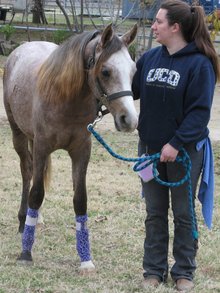According to Larry R. Bramlage, DVM, MS, castration is normally performed on colts to make them more tractable and easier to handle. When the horse has minimal breeding value, the procedure normally takes place once the horse is skeletally mature.

A horse at a castration clinic
The castration of a horse, once it is decided that it will not be a stallion, makes them much more tractable in training and a much more effective athlete.
© 2016 by NERN
In horses with potential breeding value, the decision to castrate is delayed to determine if the horse has enough athletic ability to make it attractive as a future sire.
If the horse is not a potential sire, castration increases the longevity of its race career by making the horse easier to train. The mature, intact male horse becomes progressively more difficult to train and more aggressive as it gets older.
In some horses, the timing of the castration procedure is accelerated because they will have one testicle or sometimes both testicles partially undescended, which leaves the testicle in the flank of the horse between the leg and the abdomen.
Sometimes this causes discomfort during training. If the horse has one testicle normally descended and one retained or undescended, the proper medical term is âcryptorchidâ or the horsemanâs term is âridgling.â
Non-descended testicles have much-reduced fertility or are sterile, as their retention in the inguinal canal makes them ineffective at producing sperm because of the increased temperature exposure of being adjacent to the body wall. In horses with high breeding potential, the non-descended testicle may be removed and the normal testicle will be left in place.
This horse is called a âmonorchid.â Monorchids can be fertile stallions. In horses whose pedigree does not indicate that they are likely to be a stallion, a unilateral cryptorchid is often castrated on both sides, normal and abnormal, during the same surgical procedure to facilitate the horseâs race career.
The castration of a horse, once it is decided that it will not be a stallion, makes them much more tractable in training and a much more effective athlete. Many of the famous geldings of the past were totally ineffective racehorses as intact males and became stars once gelded.
Throughout the US, from time to time, equine clinics offer either free or low cost castration clinics for horse owners who want to have their stallions or colts castrated, but don't have the funds available to pay the full cost of castration. Horse owners should check with their local equine clinics to see if they offer low-cost clinics for horses in the area.
For example, in Planty City, Florida, Dr. Britt of Hope Equine Rescue understands the cost involved with owning horses and the clinic attempts to provide low-cost services to local horse owners twice a year. These low-cost clinics include vaccines, Coggins and dental work.
The clinics are held at the vetâs office in Plant City and are by appointment only.
Horse owners in the Florida area can submit an application for the next low-cost clinic to be held during November 2016 at Submit Low-cost Clinic Application
We want to help local horse owners who canât afford to have their stallions gelded.
We hold two low cost/free clinics per year; one in the spring and one in the fall.
The cost to the owner is $50 (This price is dependent on funding. If we donât have the funding it will be $100 per horse.) and Hope Equine Rescue covers the rest. This includes sedation and castration.
Requirements:
- Horse must have two testicles dropped
- Horse must have a good halter and lead rope.
- Horse must be in good health. The vet holds the right to refuse any horse not healthy enough for surgery.
- You must have a way to get the horse to the clinic.
- Horses over two years of age are recommended to be put on bute and antibiotics. This is not included in cost.
